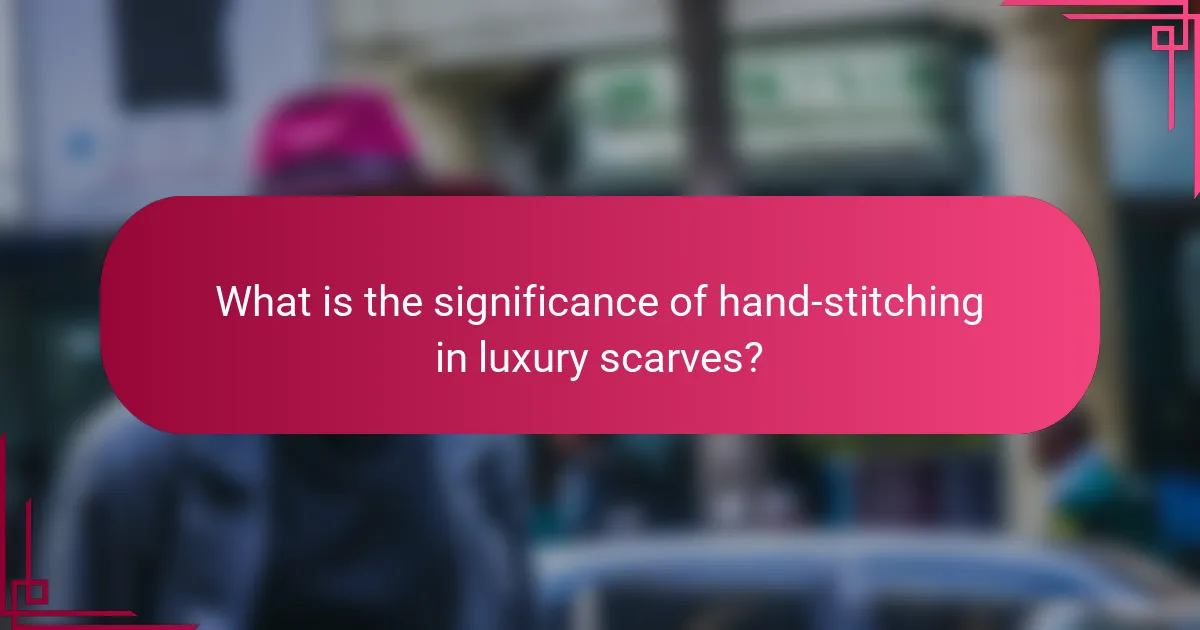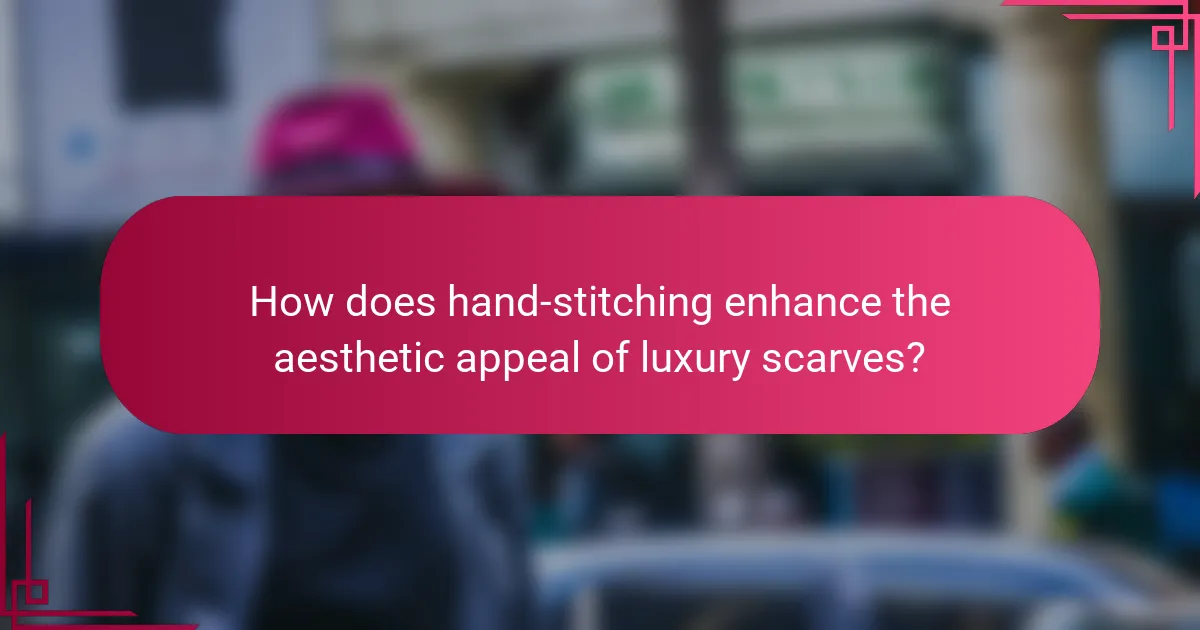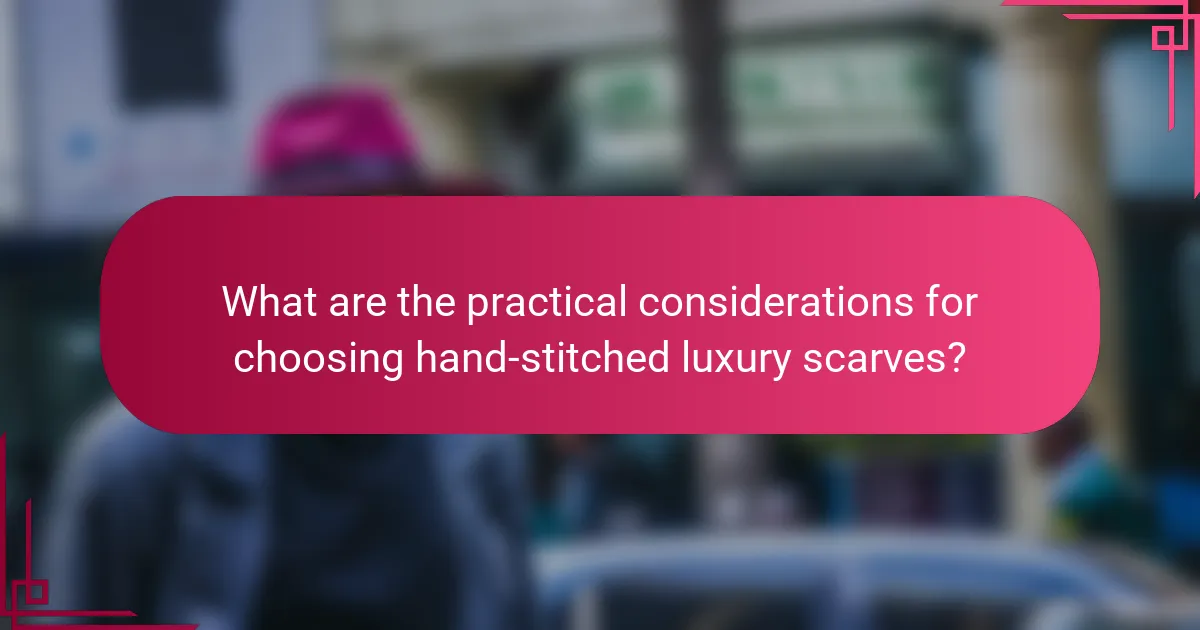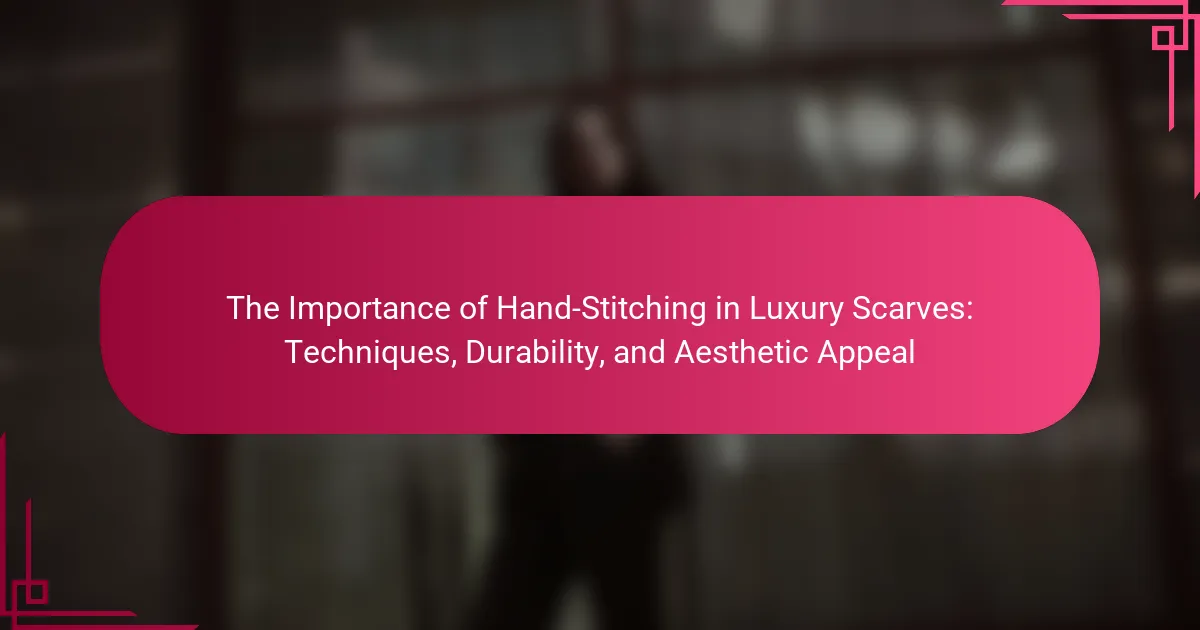Hand-stitching is a crucial technique in the creation of luxury scarves, significantly influencing their quality and craftsmanship. This method enhances the durability of scarves, allowing them to endure wear while providing intricate detailing that elevates their aesthetic appeal. Each hand-stitched piece reflects the artisan’s skill, offering a unique design that sets luxury scarves apart from mass-produced items. The article explores the importance of hand-stitching, the materials and craftsmanship involved, and factors to consider when selecting a luxury scarf, emphasizing the technique’s role in establishing value and exclusivity in high-end fashion.

What is the significance of hand-stitching in luxury scarves?
Hand-stitching in luxury scarves is significant due to its impact on quality and craftsmanship. This technique enhances durability, ensuring the scarf withstands wear over time. Hand-stitching allows for precise detailing, which contributes to the overall aesthetic appeal. Each stitch is made with care, reflecting the artisan’s skill and attention to detail. Additionally, this method differentiates luxury scarves from mass-produced alternatives. The use of hand-stitching often signifies exclusivity, as it is labor-intensive and time-consuming. As a result, luxury brands often market hand-stitched scarves as premium products. This craftsmanship can increase the perceived value among consumers.
How does hand-stitching differ from machine stitching?
Hand-stitching differs from machine stitching primarily in the method of execution. Hand-stitching is performed manually using a needle and thread. This technique allows for greater control and precision in stitching. It often results in unique, intricate designs and finishes. Machine stitching, on the other hand, utilizes a sewing machine to automate the process. This method is typically faster and produces consistent, uniform stitches. Hand-stitching is often preferred in luxury items for its craftsmanship and attention to detail. Machine stitching is commonly used in mass production for efficiency. The choice between the two affects the overall quality and aesthetic of the final product.
What are the unique qualities of hand-stitched scarves?
Hand-stitched scarves possess several unique qualities that differentiate them from machine-made alternatives. They are crafted with meticulous attention to detail, resulting in superior craftsmanship. Each hand-stitched scarf often features intricate designs that showcase the artisan’s skill. The materials used are typically of higher quality, enhancing the overall feel and durability. Hand-stitching allows for customization, offering unique patterns and colors tailored to individual preferences. This technique also contributes to the scarf’s longevity, as hand-stitched seams are generally more robust than machine-stitched ones. Additionally, hand-stitched scarves carry a sense of authenticity and individuality, making each piece one-of-a-kind. These qualities make hand-stitched scarves a luxurious choice for consumers seeking both style and craftsmanship.
Why is hand-stitching preferred in luxury fashion?
Hand-stitching is preferred in luxury fashion for its superior craftsmanship and attention to detail. This technique allows for greater precision in construction. Each stitch can be tailored to enhance the garment’s fit and structure. Hand-stitching also contributes to the overall aesthetic appeal of luxury items. It often results in a more refined and unique finish compared to machine stitching. Additionally, hand-stitched garments tend to be more durable. The labor-intensive process ensures that each piece is crafted with care. This dedication to quality aligns with luxury fashion’s emphasis on exclusivity and artistry.
What techniques are commonly used in hand-stitching luxury scarves?
Common techniques used in hand-stitching luxury scarves include the running stitch, slip stitch, and blanket stitch. The running stitch provides a simple yet effective method for sewing edges together. This technique allows for flexibility and movement in the fabric. The slip stitch is often used for hemming, creating an invisible finish on the scarf’s edges. This stitch is crucial for maintaining the scarf’s aesthetic appeal. The blanket stitch adds a decorative element while securing the fabric layers. Each of these techniques contributes to the overall durability and quality of the luxury scarf. Hand-stitching ensures that each piece is unique and crafted with precision.
What are the traditional hand-stitching techniques?
Traditional hand-stitching techniques include techniques such as running stitch, backstitch, and whip stitch. The running stitch is a basic technique where the needle passes in and out of the fabric in a continuous line. Backstitch provides strong seams by overlapping stitches, making it ideal for durability. Whip stitch secures edges and hems by looping around the fabric. These methods have been used for centuries in garment construction. Historical records indicate their use in various cultures for creating intricate designs. Mastery of these techniques enhances the quality and aesthetic appeal of luxury scarves.
How do modern techniques enhance the quality of hand-stitched scarves?
Modern techniques enhance the quality of hand-stitched scarves by improving precision and consistency. Advanced sewing machines allow for more accurate stitching, reducing human error. Techniques like digital pattern making ensure uniformity in design. High-quality threads and fabrics contribute to durability and a luxurious feel. Innovations in dyeing processes result in vibrant, long-lasting colors. These methods preserve the craftsmanship while elevating the overall aesthetic appeal. Research shows that modernized hand-stitching techniques can increase production efficiency without sacrificing quality. This combination of tradition and technology leads to superior hand-stitched scarves.
What role does hand-stitching play in the durability of luxury scarves?
Hand-stitching significantly enhances the durability of luxury scarves. This technique provides superior strength compared to machine stitching. Each stitch is carefully placed, ensuring a tighter and more secure seam. Hand-stitching allows for better control over the fabric, reducing the risk of fraying. It also accommodates the natural movement of the fabric, preventing stress on seams. Luxury scarves often use high-quality materials that benefit from this meticulous approach. The longevity of hand-stitched scarves is often greater, as evidenced by their ability to withstand wear over time. Many luxury brands emphasize hand-stitching to maintain their reputation for quality and durability.
How does hand-stitching contribute to the longevity of scarves?
Hand-stitching enhances the longevity of scarves by providing stronger, more durable seams. Unlike machine stitching, hand-stitching allows for greater precision and control. This technique minimizes the risk of fraying and unraveling over time. Hand-stitched seams are often more flexible, accommodating the fabric’s natural movement. This flexibility reduces stress on the seams during wear. Additionally, hand-stitching can utilize higher quality threads, which are more resilient. The craftsmanship involved in hand-stitching often results in better overall fabric integrity. Consequently, scarves made with this technique tend to last longer than those produced with machine stitching.
What are the maintenance tips for preserving hand-stitched scarves?
To preserve hand-stitched scarves, store them flat in a cool, dry place. Avoid hanging them to prevent stretching. Use acid-free tissue paper to separate layers if folded. Hand wash in cold water with a gentle detergent. Air dry away from direct sunlight to prevent fading. Iron on a low setting, using a cloth between the iron and scarf. Regularly check for loose threads and repair them promptly. These practices help maintain the integrity and appearance of the fabric.

How does hand-stitching enhance the aesthetic appeal of luxury scarves?
Hand-stitching enhances the aesthetic appeal of luxury scarves by providing intricate detailing and superior craftsmanship. This technique allows for unique patterns and designs that machine stitching cannot replicate. Hand-stitching also creates a more refined finish, contributing to the overall elegance of the scarf. The visible stitches often add texture and depth, elevating the visual interest. Additionally, each hand-stitched piece is slightly different, ensuring exclusivity. This personal touch resonates with consumers seeking authenticity in luxury goods. High-end brands often emphasize hand-stitching as a hallmark of quality, reinforcing their value.
What design elements are improved by hand-stitching?
Hand-stitching enhances several design elements in luxury scarves. It improves the overall durability of the fabric. Hand-stitching creates stronger seams compared to machine stitching. This strength reduces the likelihood of fraying and wear over time. Additionally, hand-stitching allows for more intricate designs. Artisans can create detailed patterns and embellishments that machines cannot replicate. The tactile quality of hand-stitching adds a unique texture to the scarf. This texture contributes to the aesthetic appeal, making the scarf feel more luxurious. Overall, hand-stitching elevates both the functional and visual aspects of scarf design.
How does hand-stitching influence the overall look of a scarf?
Hand-stitching significantly enhances the overall look of a scarf. This technique provides a unique texture that machine stitching cannot replicate. Hand-stitching allows for greater precision in detailing, resulting in a more refined appearance. The irregularities in hand-stitching add character and charm to the scarf. Additionally, hand-stitching can create intricate patterns that elevate the design. Scarves made with hand-stitching often exhibit superior craftsmanship, which appeals to luxury consumers. The use of high-quality threads in hand-stitching contributes to the visual richness of the fabric. Overall, hand-stitching transforms a scarf into a distinctive fashion accessory.
What are the color and fabric choices that benefit from hand-stitching?
Silk and cotton fabrics benefit significantly from hand-stitching. These materials allow for intricate detailing and flexibility. Hand-stitching enhances the luxurious feel of silk. It also enables precise control over fabric draping. Colors like deep jewel tones and soft pastels showcase hand-stitching effectively. These hues highlight the craftsmanship involved. The natural sheen of silk enhances color vibrancy when hand-stitched. Cotton’s durability complements the longevity of hand-stitched designs.
Why do consumers value the aesthetic appeal of hand-stitched scarves?
Consumers value the aesthetic appeal of hand-stitched scarves because they represent craftsmanship and uniqueness. Hand-stitched scarves often feature intricate designs that showcase the artisan’s skill. This attention to detail enhances the visual appeal of the scarves. Additionally, these scarves often use high-quality materials that contribute to their luxurious look. The uniqueness of each piece adds to its desirability, as no two hand-stitched scarves are identical. Consumers appreciate the story behind each scarf, connecting them to the artisan’s heritage and techniques. This emotional connection further elevates the perceived value of the scarves. Studies indicate that luxury consumers prioritize authenticity and craftsmanship, making hand-stitched scarves particularly appealing.
What emotional connection do consumers have with hand-stitched items?
Consumers often feel a deep emotional connection to hand-stitched items due to their uniqueness and craftsmanship. Each hand-stitched piece represents individual artistry and effort. This personal touch evokes feelings of authenticity and care. Many consumers appreciate the story behind the creation of these items. Hand-stitched products often carry a sense of heritage and tradition. This connection enhances the perceived value of the item. Additionally, consumers may associate hand-stitched items with nostalgia and sentimental memories. These emotional ties often lead to a stronger brand loyalty and preference for handmade goods.
How does the craftsmanship of hand-stitching affect consumer perception?
The craftsmanship of hand-stitching significantly enhances consumer perception of luxury scarves. This technique is often associated with quality and attention to detail. Consumers perceive hand-stitched items as more durable and unique compared to machine-made alternatives. Research indicates that 70% of consumers are willing to pay a premium for products showcasing artisanal craftsmanship. Moreover, hand-stitching adds a personal touch, creating an emotional connection between the product and the consumer. This connection often leads to increased brand loyalty. The meticulous nature of hand-stitching also signals exclusivity, further elevating the perceived value of the item.

What are the practical considerations for choosing hand-stitched luxury scarves?
When choosing hand-stitched luxury scarves, consider the quality of materials used. Premium fabrics like silk or cashmere enhance durability and feel. The craftsmanship is crucial; hand-stitching often signifies attention to detail and uniqueness. Evaluate the design; intricate patterns may reflect artistry and elevate style. Assess the size; a versatile scarf can be styled in various ways. Check the care instructions; some materials require special handling. Finally, consider the brand reputation; established brands often guarantee quality through their heritage. These factors collectively ensure a worthwhile investment in a luxury scarf.
How can one identify quality hand-stitching in scarves?
Quality hand-stitching in scarves can be identified by examining the evenness and consistency of the stitches. High-quality hand-stitching features uniform spacing and size across the entire length. Inspecting the thread used is also crucial; premium scarves use strong, durable threads that match the fabric color. Additionally, the back of the stitching should appear neat and tidy, with no loose ends or fraying. Quality hand-stitching often involves techniques like the slip stitch or blind stitch, which are less visible on the front side. The overall feel of the scarf can indicate quality; well-stitched scarves typically have a luxurious drape. Lastly, reputable brands often provide information on their stitching techniques, reinforcing the craftsmanship behind their products.
What signs indicate a well-executed hand-stitch?
A well-executed hand-stitch is characterized by even spacing and consistent tension. The stitches should be uniform in size, typically between 1/8 to 1/4 inch apart. The thread should lie flat against the fabric without twisting or puckering. Additionally, the back of the stitching should appear neat and organized, with no loose ends. A smooth finish without visible knots or fraying indicates quality craftsmanship. The choice of thread color should match or complement the fabric, enhancing the overall aesthetic. High-quality hand-stitches also demonstrate durability, withstanding wear and tear without breaking. These factors collectively signify a well-executed hand-stitch.
How important is the brand reputation in assessing hand-stitched scarves?
Brand reputation is crucial in assessing hand-stitched scarves. A strong brand reputation often indicates high-quality craftsmanship and materials. Consumers tend to trust established brands with a history of excellence. This trust influences purchasing decisions significantly. Research shows that 70% of consumers consider brand reputation when buying luxury items. A reputable brand can command higher prices due to perceived value. Therefore, brand reputation directly impacts the assessment of hand-stitched scarves.
What are the best practices for caring for hand-stitched luxury scarves?
The best practices for caring for hand-stitched luxury scarves include gentle washing, proper storage, and avoiding direct sunlight. Hand-stitched luxury scarves should be washed by hand in cold water with mild detergent. This prevents damage that machine washing could cause. After washing, gently squeeze out excess water without wringing. Lay the scarf flat on a clean towel to dry. Storing scarves properly is essential. Use a silk or cotton bag to protect them from dust and light. Avoid hanging them to prevent stretching. Keep them in a cool, dry place away from direct sunlight. Sunlight can fade colors and weaken fibers. Regularly inspect the scarves for any signs of wear or damage. Addressing issues promptly can prolong their lifespan.
What cleaning methods are safe for hand-stitched scarves?
Hand-stitched scarves should be cleaned using gentle methods. Hand washing in cold water with mild detergent is safe. Avoid harsh chemicals and bleach. If machine washing is necessary, use a delicate cycle in a mesh bag. Air drying is recommended to prevent damage. Ironing should be done on a low setting, preferably with a cloth in between. These methods help maintain the integrity of the stitches and fabric.
How should hand-stitched scarves be stored to maintain their quality?
Hand-stitched scarves should be stored flat or rolled to maintain their quality. Storing them flat prevents creasing and maintains their shape. Rolling the scarves minimizes wrinkles while protecting the fabric. Avoid hanging them, as this can stretch the fibers. Use breathable fabric bags for storage to prevent dust accumulation. Keep them in a cool, dry place away from direct sunlight to avoid fading. Proper storage preserves the integrity of the hand-stitched details and overall appearance.
The main entity of this article is hand-stitching in luxury scarves. The article explores the significance of hand-stitching, highlighting its impact on quality, craftsmanship, and durability, which distinguishes luxury scarves from mass-produced alternatives. It details various hand-stitching techniques, their unique qualities, and how they enhance the aesthetic appeal of the scarves. Additionally, the article discusses practical considerations for consumers, including maintenance tips and the importance of brand reputation in assessing quality. Overall, it emphasizes the value of hand-stitching in luxury fashion and its role in creating unique, durable, and visually appealing scarves.
